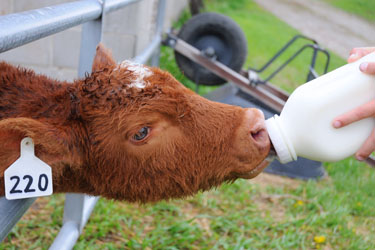Veterinarian Tips: Hand-Raising Dairy Calves

Hand raising calves is just one of the many jobs that comes with running a dairy farm. While individual farmers may differ on the length of time to leave the newborn calf with the cow, since the purpose of a dairy farm is to produce milk, as soon as possible, the cow needs to be placed on the production line. When that happens, the calf and cow are separated, and the raising of the calf goes to a member of the farm.
The following information provides tips for clients who are hand-raising dairy calves:
Tip #1. Colostrum
After giving birth, the first milk of the cow will be colostrum. This milk contains the maternal antibodies that will protect the calf against infectious diseases.
- Newborn calves should get between 2 to 3 liters of colostrum within the first 6 to 24 hours following birth
- After drinking, the calf may lie down to rest, possibly for a time period of 12 hours
- If the cow is milked out and there is extra, the excess colostrum may be frozen and saved for future use for either her calf or for others.
Tip #2. Drinking Lessons
Teaching a calf to drink milk requires a little patience. Unless the animal is ill, it will eventually catch on to the process!
Using a type of teat system to train the calf to eat/drink is suggested for the following reasons:
- Most calves will take to a teat and drink without any problems
- Saliva is necessary to help with digesting food, and sucking on a teat promotes its production
- Using a teat eliminates problems that occur when some calves drink too fast from a bucket or end up with air in the stomach
One method to teach a calf to drink is to dip fingers in warm milk and offer them to the calf to suckle. If the calf doesn’t suck well, moving fingers against its tongue and the roof of its mouth will help to stimulate the suckling reflex.
As the calf becomes interested, lower fingers back to the teat that has also been dipped in milk. It may take a few tries, but training to drink from a teat is easily accomplished.
Tip #3. Feeding Requirements
Advise clients to use either fresh cow milk or a full cream milk replacer. They should not use skim milk powder or diluted cow milk.
- Feed calves twice a day for the first two weeks
- Feed once daily after that. Feeding at night lets them rest with a full stomach.
Tip #4. Weaning
Many view the age to wean a calf differently. Some feel the best time to wean occurs when the animal is around 7 to 8 weeks of age. Research also indicates times when weaning can be successfully dropped to 28 days.
Tip #5. Water
Always provide fresh water to calves even when they are drinking milk. When weaned, they will already know what it is and how to drink, which will help them when they are weaned from drinking milk.
Tip #6. Solid Food
From one week of age, give calves access to good hay and quality pasture. The fiber of hay helps the animal to initiate rumination activity while aiding digestion. Learning to forage on pasture grass helps them become familiar with eating food, which, when weaned from milk, will help to reduce stress and the chance for weight loss. Pasture provides the necessary microbes that allow for proper rumen development.
Help Your Dairy Clients
The first few months of a dairy calf’s life are important to its growth, as well as its future potential on the milk line. Hand raising takes time and effort, but starting them off in the right direction will be worth it! Your encouragement may make a difference in your dairy clients’ profits.
At Covetrus, we believe the more information veterinarians provide clients, the more likely your clients will return. Here’s some additional information to pass on to your clients who have dairy cattle:
- Dairy Cattle Udder Hygiene
- Veterinarian Tips: Fat Cow Syndrome
For you, the veterinarian, Covetrus offers this free white paper, Obstacles and Opportunities Facing Livestock Veterinarians.
Contact your Covetrus representative for additional information to help clients with dairy herds online or at 855.724.3461.
http://farmstyle.com.au/news/part-one-calf-rearing-%E2%80%93-small-farmers%E2%80%99-guide-feeding-and-raising-calves
http://hoards.com/article-1839-Early-weaning-saves-you-time-and-money.html
Careers
Are you looking for a place to let your talents shine? At Covetrus, we help our practitioner customers better serve their patients and take pride in providing the best customer experience possible. Search our open positions to see our available opportunities.
Newsletter
Stay current with what’s going on with Covetrus, subscribe to receive our newsletter and email communications. Subscribers will receive the latest information in practice management, sales and marketing, animal health, and more.


Leave a comment